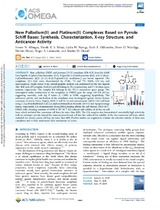New palladium(II) and platinum(II) complexes based on pyrrole Schiff bases: synthesis, characterization, X-ray structure, and anticancer activity

View/
Date
2020Author
Mbugua, Simon N.
Sibuyi, Nicole R. S.
Njenga,Lydia W.
Metadata
Show full item recordAbstract
New palladium (Pd)II and platinum (Pt)II complexes (C1−C5) from the Schiff
base ligands, R-(phenyl)methanamine (L1), R-(pyridin-2-yl)methanamine (L2), and R-(furan2-yl)methanamine (L3) (R-(E)-N-((1H-pyrrol-2-yl) methylene)) are herein reported. The
complexes (C1−C5) were characterized by FTIR, 1
H and 13C NMR, UV−vis, and
microanalyses. Single-crystal X-ray crystallographic analysis was performed for the two ligands
(L1−L2) and a Pt complex. Both L1 and L2 belong to P21/n monoclinic and P-1 triclinic space
systems, respectively. The complex C5 belongs to the P21/c monoclinic space group. The
investigated molar conductivity of the complexes in DMSO gave the range 4.0−8.8 μS/cm,
suggesting neutrality, with log P values ≥ 1.2692 ± 0.004, suggesting lipophilicity. The
anticancer activity and mechanism of the complexes were investigated against various human
cancerous (Caco-2, HeLa, HepG2, MCF-7, and PC-3) and noncancerous (MCF-12A) cell lines
using 3-(4,5-dimethylthiazol-2-yl)-2,5-diphenyltetrazolium bromide (MTT) and Apopercentage
assays, respectively. C5 demonstrated strong DNA-binding affinity for calf thymus DNA (CTDNA) with a binding constant of 8.049 × 104 M−1
. C3 reduced cell viability of all the six cell
lines, which included five cancerous cell lines, by more than 80%. The C5 complex also demonstrated remarkably high selectivity
with no cytotoxic activity toward the noncancerous breast cell line but reduced the viability of the five cancerous cell lines, which
included one breast cancer cell line, by more than 60%. Further studies are required to evaluate the selective toxicity of these two
complexes and to fully understand their mechanism of action
